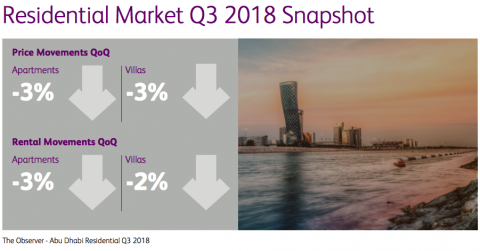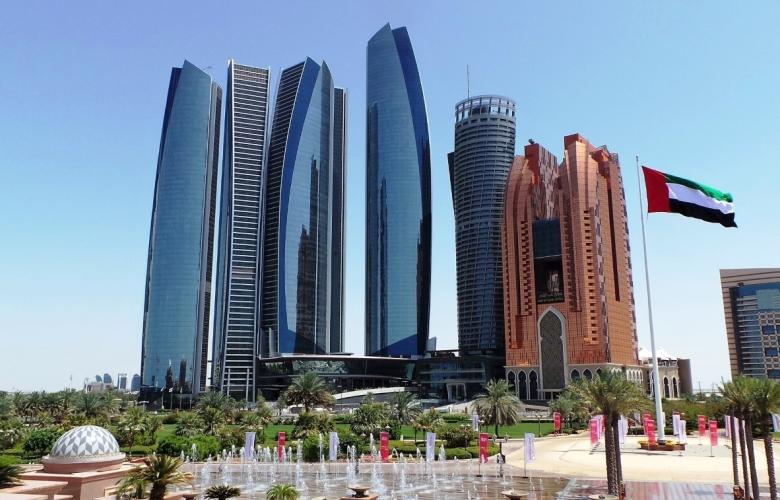Residents opting to buy properties in Abu Dhabi rather than rent, says Chestertons
Residents opting to buy properties in Abu Dhabi rather than rent, says Chestertons
Property prices in Abu Dhabi have had continued downward adjustments says latest Chestertons Observer: Abu Dhabi Market Report Q3 2018.
Abu Dhabi real estate sales prices and rental rates are facing continued pressure, a result of unfavourable macroeconomic conditions, compounded by further supply entering the market, according to research from international real estate services firm, Chestertons, latest Observer: Abu Dhabi Market Report Q3 2018.
In addition to new developments entering the market, ongoing redundancies and companies offering lower rental allowances are adding further units to the market place and hampering rental rates. As such, average rental rates were down 3% for apartments and 2% for villas quarter on quarter.
“Even the more resilient apartment locations such as Saadiyat were faced with declining rates, admittedly of just 1% overall, with studios and one-bedroom apartments unchanged from Q3. This has, however, allowed some tenants to take advantage of the downturn by using the opportunity to upgrade to larger units with better-quality specifications, located in more popular areas,” said Ivana Gazivoda Vucinic, Head of Consulting, Chestertons MENA.

Average rental rates were down 3% for apartments and 2% for villas quarter on quarter. Image credit: Chestertons.
The biggest adjustments in the apartment rental market were seen in Al Reem Island and the Al Raha Beach area both returning 4% declines quarter on quarter – with studio apartments priced per annum at AED50,000 and AED68,000 respectively. However, when compared to Q4 2017, the highest price point in the last year, Al Raha Beach has seen a 30% decrease in rental asking prices for studios.
Similarly to apartments, villa rentals in Al Reem Island observed the greatest drop at 6% with a four-bedroom now available for AED235,000 per year. Locations that remained unchanged in the villa market in Q3 included Al Ghadeer, Khalidiya and Khalifa City with four-bedrooms in the latter renting for AED185,000 and AED170,000 respectively.
“The shift in market dynamics has resulted in several landlords focusing on retaining tenants rather than facing long periods without any rental income, particularly in a market where we’re seeing some tenants moving to save a few thousand dirhams a year on their rental budget,” added Vucinic.
The apartment sales market softened across the board with Al Ghadeer showing the steepest decline with a 6% drop to AED866 per square foot. Saadiyat Island, which had previously witnessed the biggest drop in Q2 at 6%, was more resilient with only a 1% decline to AED1,400 per square foot, suggesting the area is starting to reach more realistic pricing levels.
In the villa sales market, as with the apartment market, Al Ghadeer saw the greatest decline quarter on quarter of 5% to AED766 per square foot. Khalifa City fared better, with a decline of just 2% to AED875 per square foot whilst Al Reef remained unchanged at AED690 per square foot. In a bid to provide some respite to the Abu Dhabi real estate market, Abu Dhabi Government has announced 50 new initiatives as part of its AED50 billion stimulus package, reflecting the priorities of citizens, residents and investors. Over AED20 billion has been allocated to the 2019 package.”
“Abu Dhabi Government will play a pivotal role in the recovery of its real estate industry with initiatives such as the regional and global promotion of the Emirate expected to have a positive impact. However, until the effects of initiatives such as this are realised, the real estate sector is likely to suffer continued price adjustments into 2019,” said Vucinic.
To view the full report, go to the Chestertons website.
For more information about the Observer: Abu Dhabi Market Report Q3 2018, email Ivana Vucinic of Chestertons MENA via the contact details below.
See also:
Abu Dhabi to host 10th World Urban Forum in 2020
MENA region's largest diversified real estate investment company





